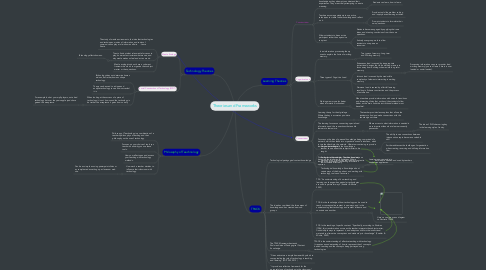
1. Technology Theories
1.1. Media Ecology
1.1.1. The study of media environments, the idea that technologies and techniques, modes of information and codes of communication play a role in human affairs. - Lance Strate
1.1.2. Tries to find out what roles media forces us to play, how media structures what we see, and why media makes us feel and act as we do.
1.1.2.1. Technology affects humans.
1.1.3. Media ecologists do not have a coherent framework in which to organize their subject matter or their questions.
1.2. Social Construction of Technology (SCOT)
1.2.1. Technology does not determine human actions, but rather, humans shape technology.
1.2.2. Theory can be used to critique and analyze technology to see how successful it is.
1.2.3. When looking at the success of a piece of technology it is not how sound the technology is but rather the acceptance it gains from society.
1.2.3.1. For example look at your mp3 players, not a bad technology but over the years apple ipods have gained the acceptance.
2. Philosophy of Teachnology
2.1. Philosopy of Teachnology is a combination of a teachers philosophy on teaching and their philosophy on the use of technology.
2.2. Focuses on your choice of tools you teach with and why you use these tools.
2.3. How you reflect upon and assess your teaching with technology methods.
2.4. How much a teacher decides to influence their classroom with technology.
2.4.1. Can be as simple as using powerpoint slides or as complicated as setting up a classroom web site.
3. Learning Theories
3.1. Constructivism
3.1.1. Students are not a blank slate. Learners create knowledge as they attempt to understand their experiences. They are actively attempting to create meaning.
3.1.1.1. Students can learn, how to learn.
3.1.2. Teachers encourage students to use active techniques to create further knowledge and reflect on it.
3.1.2.1. Provides tools like problem solving and inquiry-based learning activities.
3.1.2.2. Prompt students to formulate their own questions.
3.1.3. Allows students to be an active participant rather than a passive recipient.
3.1.3.1. Students become engaged by applying their own ideas, and drawing conclusions from their own questions.
3.1.3.2. Actively uses group work to allow students to use peers as resources.
3.2. Cognitive Load
3.2.1. Is an information processing theory used to explain the limits of working memory.
3.2.1.1. Two types of memory: Long term and Working memory.
3.2.2. Three types of Cognitive Load.
3.2.2.1. Extraneous load is caused by inappropriate instructional designs that force working memory to focus away from building schemas into long term memory.
3.2.2.1.1. Processing information can over or under load working memory (you can't learn if brain is over loaded or under loaded).
3.2.2.2. Intrinsic load is caused by the irreducible complexity of elements interacting in working memory.
3.2.2.3. Germane load is caused by effortful learning resulting in Schema construction and the process of automation.
3.2.3. Working memory works better when information is chunked.
3.2.3.1. When teachers provide information with smooth transitions and interesting slides (but not busy) the students follow better, as the brain finds this instructional method most beneficial.
3.3. Connectivism
3.3.1. Learning theory for the digital age. Where the key is accurate up-to-date knowledge.
3.3.1.1. The teacher provides lesson plans that allows the students to find and make connections with the knowledge out there.
3.3.2. The learning focuses on connecting specialized information and the connections that enable learners to learn more.
3.3.2.1. Where access to what information is needed is more important than what a learner currently possesses.
3.3.2.1.1. The idea of PLN's becoming key in the learning style of today.
3.3.3. Focuses on the idea of personal knowledge being comprised of a network, which then feeds into organizations and institutions, which in turn feedback into the network. Ultimatum continuing to provide learning to an individual.
3.3.3.1. The ability to see connections between ideas and concepts becomes a valuable skill.
3.3.3.2. Further addresses the challenge of organization when creating, reserving and utilizing information flow.
3.3.4. Driven by the understanding that decisions are based on rapid altering foundations. Where learning is a process of connecting information sources.
3.3.4.1. Learning now can reside in non-human appliances.
4. TPACK
4.1. Technological pedagogical content knowledge
4.1.1. Content knowledge: Is the knowledge a teacher knows about the subject matter to be taught.
4.1.2. Pedagogical knowledge: Teachers knowledge on methods of how to portray their subject content to their students effectively.
4.1.2.1. All three are needed and used by teachers.
4.1.3. Technological knowledge: Knowledge about certain ways of thinking about, and working with technology, tools and resources
4.2. The idea has combined the three areas of knowledge and has created new sub groups
4.2.1. TPK: "An understanding of how teaching and learning can change when particular technologies are used in particular ways" (Koehler & Mishra, 2009).
4.2.2. TCK:It is the knowledge of how technology can be used to teach or conceptualize content in new ways; and is the understanding that technology and content influence and constrain one another
4.2.2.1. Here's a common venn diagram to illustrate TPACK
4.2.3. PCK: Is the teaching of specific content. "Specifically, according to Shulman (1986), this transformation occurs as the teacher interprets the subject matter, finds multiple ways to represent it, and adapts and tailors the instructional materials to alternative conceptions and students’ prior knowledge" (Koehler & Mishra, 2009).
4.3. The TPACK framework extends Shulman’s idea of Pedagogical Content Knowledge.
4.3.1. TPACK is the understanding of effective teaching with technology. It requires an understanding of how to represent the of concepts behind teaching and the concepts being portrayed using technologies.
